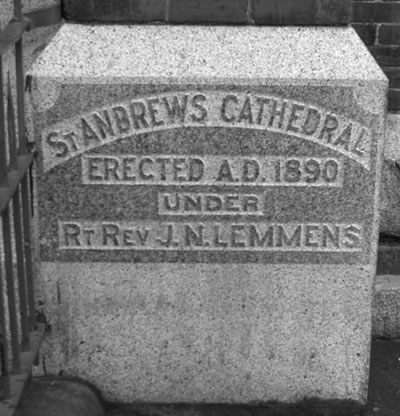Cornerstones
A Cornerstone is a ceremonial masonry stone set in a prominent location on the outside of a building. There is often an inscription on the stone indicating the construction dates of the building and the names of the architect, builder or other significant individuals.
This picture shows the 5 tonne cornerstone of St. Andrew's Cathedral at the corner of View and Blanshard Street in downtown Victoria.
The cornerstone is usually placed above the actual foundation for visibility and an aura of prominence.The placement of the cornerstone usually involves some sort of ceremony. Traditionally, ceremonies involve a special trowel that is used to lay the mortar under the stone. A hammer is used to tap the stone into place on the mortar. Sometimes offerings accompany the laying of the cornerstone: grain or rice, wine, and oil are placed on or under the stone to symbolize the people involved and their means of subsistence. In ancient times there was a practice of placing live humans or animals into the foundation to serve as a sacrifice to God and ensure the stability of the building.
Cornerstones often contain a cavity in which a time capsule or 'votive deposit' could be placed. Historically, local newspapers, coins in circulation, and other artifacts relevant to the time period were placed within the vessel. Today, most vessels are to be opened on a given date; traditionally, vessels were deposited with the hopes and intentions that they would never be disturbed.
The cornerstone was commonly placed in the Northeast corner of the structure because it was thought to be an auspicious position. Traditionally, Victoria's Victorians laid cornerstones in buildings of Judeo-Christian origin.
Origins of cornerstones are vague, but in many cases refer back to biblical reference such as the following:
- Old Testament, Psalms 118:22,
“the stone which the builders refused is become he head [stone] of the corner. This is the Lord’s doing; it is marvelous in our eyes.”
- New Testament, Matthew 21:42,
“Jesus saith unto them, “Did ye never read in the scriptures, the stone which the builders rejected, the is become the head of the corner: this is the Lord’s doing, and it is marvelous in our eyes?”
- New Testament, Act 4:11,
“this is the stone which was set at nought of you builders, which is become the head of the corner”
- New Testament, 1 Peter 2:7,
“unto you therefore which believe [he is] precious: but unto them which be disobedient, the stone which the builders disallowed, the same is made the head of the corner,”






